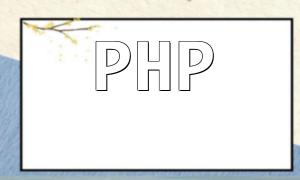In today's globalized internet world, building a multilingual website has become increasingly important. With PHP, you can easily add multiple language options to your website, providing a more personalized experience for users from different regions. This article will walk you through the process of using PHP to build a multilingual website, overcoming language barriers, and enhancing the global reach and appeal of your site.
First, you need to create a database table to store multilingual content for your website. This table will hold the translation information for different languages. Here's the SQL statement to create the table:
CREATE TABLE translations (id INT NOT NULL AUTO_INCREMENT,locale VARCHAR(255) NOT NULL,key VARCHAR(255) NOT NULL,value TEXT NOT NULL,PRIMARY KEY (id));To allow users to choose their preferred language, you can add a language switcher in the header or sidebar of your website. By using a simple GET parameter, users can select the language they want. Here's an example of how to implement it:
// Get current language$current_locale = isset($_GET["locale"]) ? $_GET["locale"] : "en";// Language links$languages = array("en", "es", "fr");foreach ($languages as $lang) { echo "<a href=?locale=$lang">$lang</a> ";}To load the appropriate translations based on the user's selected language, you need to fetch the translation data from the database. Here's how you can do it:
// Query translations$translations = $db->prepare("SELECT * FROM translations WHERE locale = ?");$translations->execute(array($current_locale));// Store translations in an array$tr = array();foreach ($translations as $row) { $tr[$row["key"]] = $row["value"];}To display the translated content on your HTML page, use the `gettext` function to retrieve the translation based on the current language:
// Use gettext to fetch translationsecho gettext("This is a test");For dates and times, you can use PHP's Intl extension to handle internationalization. This ensures that the date and time are displayed in the correct format for different regions:
// Create DateTime object$dt = new DateTime();// Set timezone$dt->setTimezone(new DateTimeZone("Europe/London"));echo $dt->format("Y-m-d H:i:s");Similarly, you can also use the Intl extension to format numbers and currencies according to the user's locale. Here's how to format currency in the US format:
// Create NumberFormatter object$formatter = new NumberFormatter("en_US", NumberFormatter::CURRENCY);// Format currency$amount = 1000;echo $formatter->formatCurrency($amount, "USD");To keep your code clean and organized, you can write functions to simplify the process of translation and internationalization. For example, you could create a helper function like this:
function t($key) { global $tr; return isset($tr[$key]) ? $tr[$key] : $key;}By following the steps outlined in this article, you can easily build a multilingual website with PHP that eliminates language barriers and increases your site's global reach. Whether it's translating text, internationalizing dates and times, or formatting currency, PHP provides powerful tools to ensure your website is accessible to users around the world.










